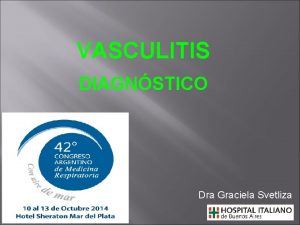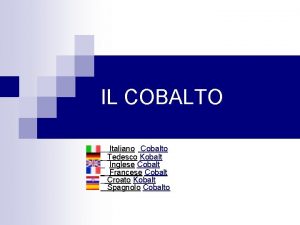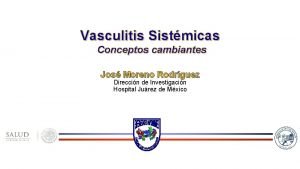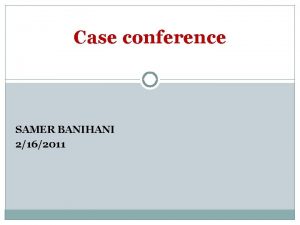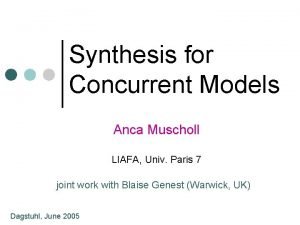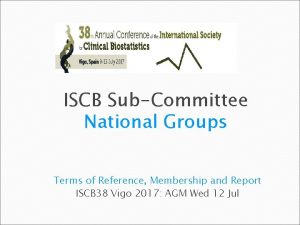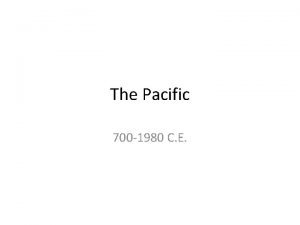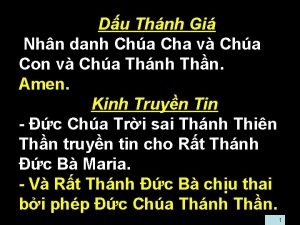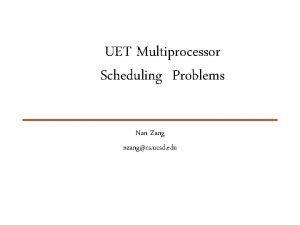Avramescu Andrei Fratila Anca Nan Alexandru Contents 1


















- Slides: 18

Avramescu Andrei Fratila Anca Nan Alexandru

Contents 1. Historic 2. Types of water 2. 1 Waterwheels 2. 2 Hidroelectric power 2. 3 Tidal power 2. 4 Wave power 3. World renewable energy

1. Historic • Water power designates the flow energy of flowing water, which is converted over suitable machines into mechanical energy. In earlier times this mechanical energy in mills directly used, today outweighs the further transformation to electricity in hydro-electric power plants. • Large scale hydroelectric power has been used worldwide for a long time to generate huge amounts of power from water stored behind massive dams. Small scale hydropower has been used for hundreds of years for manufacturing, including milling grain, sawing logs and manufacturing cloth. However, it can also be used without a dam to generate electricity for home scale remote power systems. These socalled micro-hydro installations can be a very good complement to a solar power system, as they produce electricity 24 hours a day.

2. 1 Waterwheels A water wheel consists of a large wooden or metal wheel, with a number of blades or buckets arranged on the outside rim forming the driving surface. Most commonly, the wheel is mounted vertically on a horizontal axle, but the tub or Norse wheel is mounted horizontally on a vertical shaft. Vertical wheels can transmit power either through the axle or via a ring gear and typically drive belts or gears; horizontal wheels usually directly drive their load. A flowing stream was often dammed in order to maintain a steady supply of water for the mill; the dammed water would form a mill pond. A channel created for the water to follow while flowing to or from a water wheel is a mill race(also spelled millrace) or simply a "race", and is customarily divided into sections. The race bringing water from the mill pond to the water wheel is a headrace; the one carrying water after it has left the wheel is commonly referred to as a tailrace.

Horizontal wheel: The wheel is usually mounted inside the mill building below the working floor. A jet of water is directed on to the paddles of the water wheel, causing them to turn. This is a simple system, usually used without gearing so that the axle of the waterwheel become the spindle of the mill. This system is sometimes called the Norse mill. In a sense it is the ancestor of the modern turbine. Undershot wheel: A vertically-mounted water wheel that is rotated by water striking paddles or blades at the bottom of the wheel is said to be undershot. This is generally the least efficient, oldest type of wheel (with the exception of the poncelet wheel). It has the advantage of being cheaper and simpler to build, but is less powerful and can only be used where the flow rate is sufficient to provide torque. Breastshot wheel: A vertically-mounted water wheel that is rotated by falling water striking buckets near the center of the wheel's edge, or just above it, is said to be breastshot. Breastshot wheels are the most common type in the United States of America and are said to have powered the American industrial revolution.

Overshot wheel: A vertically-mounted water wheel that is rotated by falling water striking paddles, blades or buckets near the top of the wheel is said to be overshot. In true overshot wheels the water passes over the top of the wheel, but the term is sometimes applied to backshot or pitchback wheels where the water goes down behind the waterwheel. A backshot wheel (also called pitchback) is a variety of overshot wheel where the water is introduced just behind the summit of the wheel. It combines the advantages from breastshot and overshot systems, since the full amount of the potential energy released by the falling water is harnessed as the water descends the back of the wheel.

2. 2. Hydroelectric Power Hydropower or hydraulic power is the force or energy of moving water. It may be captured for some useful purpose. Prior to the widespread availability of commercial electric power, hydropower was used for irrigation, and operation of various machines, such as watermills, textile machines, and sawmills. A trompe produces compressed air from falling water, which could then be used to power other machinery at a distance from the water. Natural manifestations of hydraulic power In hydrology, hydropower is manifested in the force of the water on the riverbed and banks of a river. It is particularly powerful when the river is in flood. The force of the water results in the removal of sediment and other materials from the riverbed and banks of the river, causing erosion and other alterations.


Hydropower produces essentially no carbon dioxide or other harmful emissions, in contrast to burning fossil fuels, and is not a significant contributor to global warming through CO 2. Hydroelectric power now supplies about 715, 000 MWe or 19% of world electricity (16% in 2003). Large dams are still being designed. Apart from a few countries with an abundance of it, hydro power is normally applied to peak load demand because it is readily stopped and started. Nevertheless, hydroelectric power is probably not a major option for the future of energy production in the developed nations because most major sites within these nations are either already being exploited or are unavailable for other reasons, such as environmental considerations. Hydraulic turbine and electrical generator.

How hydropower works Mechanical energy is derived by directing, harnessing, or channeling moving water. The amount of available energy in moving water is determined by its flow or fall. Swiftly flowing water in a big river, carries a great deal of energy in its flow. So, too, with water descending rapidly from a very high point. In either instance, the water flows through a pipe, or penstock, then pushes against and turns blades in a turbine to spin a generator to produce electricity. In a run-of-the-river system, the force of the current applies the needed pressure, while in a storage system, water is accumulated in reservoirs created by dams, then released when the demand for electricity is high. Meanwhile, the reservoirs or lakes are used for boating and fishing, and often the rivers beyond the dams provide opportunities for whitewater rafting and kayaking. Hoover Dam, a hydroelectric facility completed in 1936 on the Colorado River between Arizona and Nevada, created Lake Mead, a 110 -mile-long national recreational area that offers water sports and fishing in a desert setting.


Advantages • • The upper reservoir and dam of the Ffestiniog pumped storage scheme. 360 megawatts of electricity can be generated within 60 seconds of the need arising. The major advantage of hydroelectricity is elimination of the cost of fuel Since hydroelectric dams do not burn fossil fuels, they do not directly produce carbon dioxide (a greenhouse gas). Reservoirs created by hydroelectric schemes often provide facilities for water sports, and become tourist attractions in themselves Disadvantages • Hydroelectric projects can be disruptive to surrounding aquatic ecosystems. • The reservoirs of power plants in tropical regions may produce substantial amounts of methane and carbon dioxide. • Another disadvantage of hydroelectric dams is the need to relocate the people living where the reservoirs are planned

2. 3 Tidal power • • Tidal power, sometimes called tidal energy, is a form of hydropower that exploits the movement of water caused by tidal currents or the rise and fall in sea levels due to the tides. Although not yet widely used, tidal power has potential for future electricity generation and is more predictable than wind energy and solar power. In Europe, tide mills have been used for over a thousand years, mainly for grinding grains. Harnessing the tides in a bay or estuary has been achieved in France (since 1966), Canada and Russia, and could be achieved in other areas with a large tidal range. The trapped water turns turbines as it is released through the tidal barrage in either direction. Another possible fault is that the system would generate electricity most efficiently in bursts every six hours (once every tide). This limits the applications of tidal energy. Tidal power is generated by the gravitational pull of both the Sun and the Moon on water. Due to these gravitational forces, water levels follow periodic highs and lows. The height of the tide produced at a given location is the result of the changing positions of the Moon and Sun relative to the Earth coupled with the • The tidal energy generator uses this phenomenon to generate energy. The higher the height of the tide the more promising it is to harness tidal energy.

Tidal stream power • • A relatively new technology, tidal stream generators draw energy from currents in much the same way as wind turbines. The higher density of water, 832 times the density of air, means that a single generator can provide significant power. Similar to wind power, selection of location is important for the tidal turbine. Tidal stream systems need to be located in areas with fast currents where natural flows are concentrated between obstructions, for example at the entrances to bays and rivers, around rocky points, headlands, or between islands or other land masses.

2. 4. Wave power Harnessing power from ocean surface wave motion might yield much more energy than tides. The feasibility of this has been investigated, particularly in Scotland in the UK. Generators either coupled to floating devices or turned by air displaced by waves in a hollow concrete structure would produce electricity. Numerous technical problems have frustrated progress.



The end Coordinated by : Schnabel Dieter
 Bacrea
Bacrea Production of red blood cells
Production of red blood cells Vasculitis anca
Vasculitis anca Protesi di rivestimento anca in ceramica
Protesi di rivestimento anca in ceramica Le secret d'anca
Le secret d'anca Mcd nedir tıp
Mcd nedir tıp Anca αγγειιτιδεσ
Anca αγγειιτιδεσ Vasculitis anca
Vasculitis anca Cycazarem
Cycazarem Anca muscholl
Anca muscholl Anca vitcu
Anca vitcu Hola formal
Hola formal Billy elliot brother
Billy elliot brother Ap art history
Ap art history Kinh bởi trời tổng giáo phần hạ nơi
Kinh bởi trời tổng giáo phần hạ nơi Where are you
Where are you Nan zang
Nan zang Blue nan group
Blue nan group Sì kǒu rén
Sì kǒu rén


